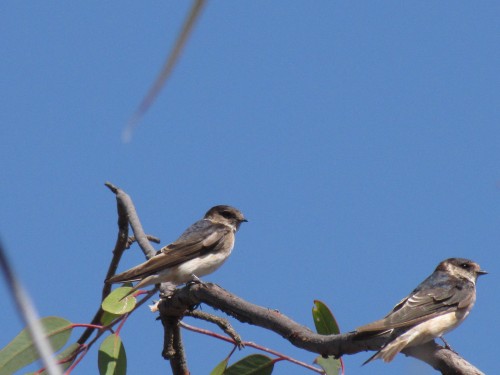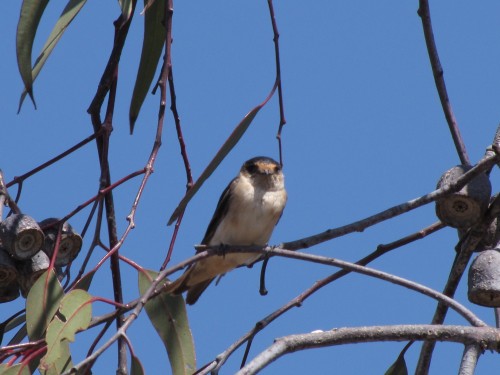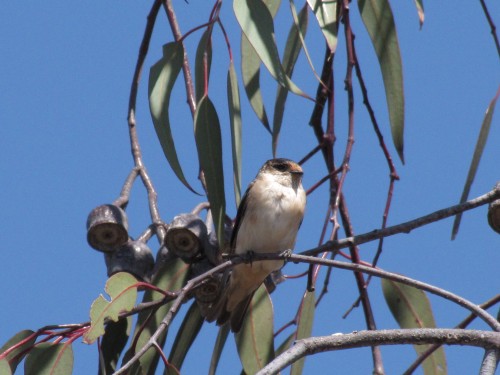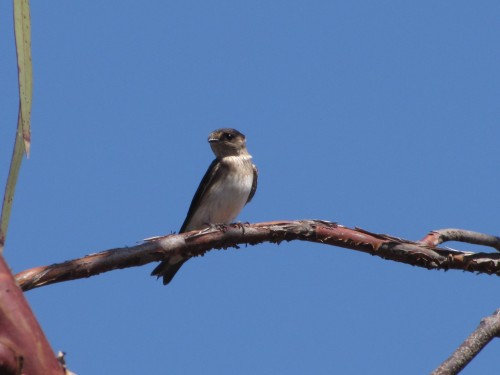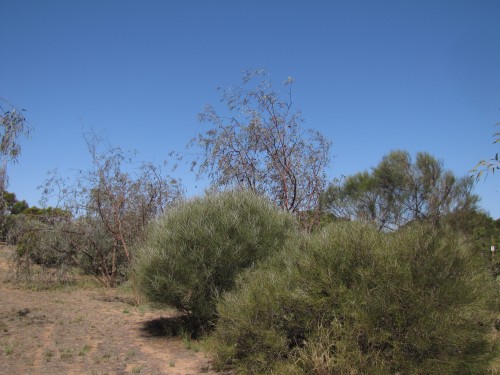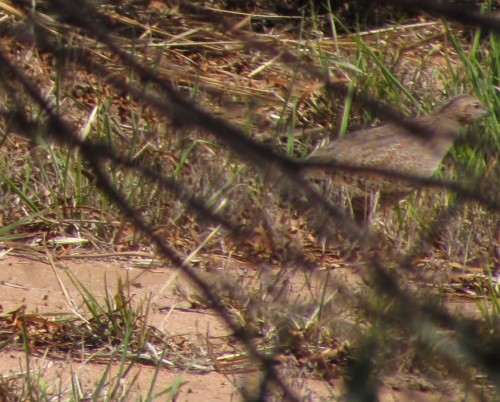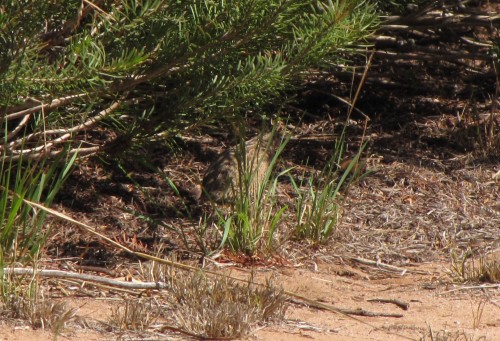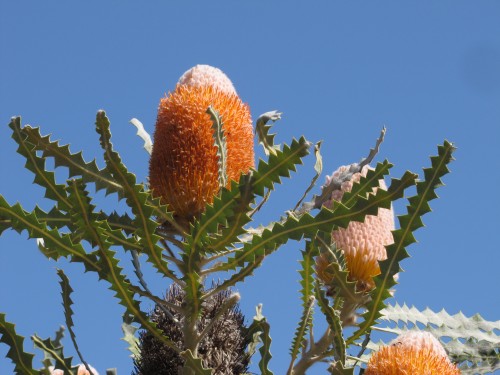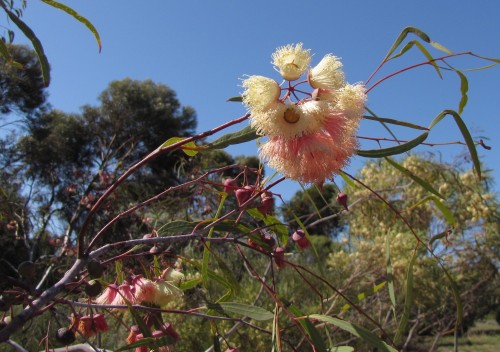Tree Martins all a twitter
A few weeks ago we had a day out with friends of ours. It was my wife’s birthday and after a wonderful lunch in one of the local hotels, we drove from Murray Bridge down south to Wellington. We had a twenty-minute wait to cross the River Murray on the local ferry; for some reason, we struck a very busy time. Driving off the ferry and heading east towards Tailem Bend for about a kilometre we turned off to the left. Several hundred metres on we came to the Pangarinda Botanic Gardens, one of our favourite places to visit near where we live.
These gardens, formerly known as an arboretum, are extensive plantings over 12 hectares of Australian native plants. This is always of particular interest to my wife – you can visit her site Mallee Native Plant Nursery here. While our visit coincided with the latter part of a very hot and dry summer, there was still a good variety of plants flowering. Late winter and early spring are certainly the best times to visit.
I have also found that wherever one finds extensive stands of Australian plants, there is also a good chance of a pleasing variety of birds. We found a newly installed picnic table to enjoy an afternoon cuppa and some birthday cake. While we sat there enjoying the bright, sunny day and gentle breeze, I was able to make a good list of birds seen and heard.
One of the bird species I quickly saw was the Tree Martin. A loose flock of about 50 or 60 martins were swooping and soaring overhead and over one particular group of eucalyptus trees about 50 metres away. After enjoying our cuppa my friend Keith and I wandered over to get a closer look. We could see that many of the martins were perching on several trees. Now I immediately thought that this was a good opportunity to get some close-up photos of this species. Usually, I only get to see this species on the wing, usually high overhead, not a good way of getting photos of this small species. They also fly very quickly.
I was able to approach to within about 10 metres of the tree and I managed to take a series of lovely photos as shown in today’s post (see above and below). While I have seen individuals and even a small group landing near to each other in a tree or on electricity wires, this is the first time I have seen such large numbers all settling near to one another. I am not sure why they were doing this. Then after a minute or so they would all take off again for a minute or two, before settling in the trees again. Perhaps they were just letting their food settle; there were plenty of insects on the wing that day so it was a feast for them, I guess.
Further reading:
Calling up a Brown Quail
Yesterday was my wife’s birthday.
To celebrate we went out to lunch with friends, and then drove south to Wellington on the River Murray. After crossing the river on the ferry we drove the short distance to the Pangarinda Botanic Gardens (formerly known as the Pangarinda Arboretum). My wife enjoys exploring places where native Australian plants are the feature. You can check out her site about Australian plants here.
We found a shady spot in the middle of the gardens, complete with a table and seats. The garden all around us was alive with birds, especially dozens of New Holland Honeyeaters. We also saw White-browed Babblers, Red Wattlebirds and Little Wattlebirds, along with dozens of Tree Martins soaring on the breeze hawking for insects (photos to come in a few days’ time).
As we were having a cuppa and some delicious birthday cake, we heard an interesting call nearby. It wasn’t long before we spotted a quail-like bird skulking through the garden about 50 metres away. I checked my bird app on my phone and immediately recognised the call of the Brown Quail. I knew that I didn’t have a photo of this species, so I set off in pursuit. I actually managed only two photos which I have cropped and shown here today. They are not brilliant photos, but they are the best I have.
This is the first time I have seen this species, even though they are relatively widespread in the region where I live. They can be quite shy birds, hiding in grasses and bushy areas. I guess that they have found these gardens to their liking and are getting used to people being around quite often. I was amused when my friend Keith started imitating the call – and both birds answered him from nearby. They also answered the call from the app on my phone. Neither Keith’s call, nor that from my phone made them come closer to investigate. At one point one of them did fly low over the table where we were sitting, but it went straight into a bushy area and out of sight.
As far as I can tell from my memory and records, this sighting is a “lifer“, that is, it is the first time in my life I have seen this species.
Further reading (click on the title):
- Mallee Native Plants – my wife’s site about Australian plants
- Pangarinda Arboretum – some flower photos are featured in this post
- Birds and plants of Pangarinda Arboretum – more photos of the beautiful plants in these gardens
- Spotted Nightjar at Pangarinda
- Red-capped Robin at Pangarinda – featuring possibly my favourite photos of any bird
Below I have included several flower photos taken yesterday.
Great Cormorants
Last night I had a meeting at Wellington in South Australia, about a half hour drive south of home here in Murray Bridge. As we crossed the river on the ferry I commented to my friend who was driving about the number of Australian Pelicans swimming near the ferry. There must have been about 15 of them. I didn’t have my camera and it was almost dark anyway.
Last year I crossed the River Murray on the same ferry during the day and took the photos on this post – but didn’t share them at the time. This is an example of taking birding a little too casually. I thought the birds I had photographed were Little Black Cormorants. When I looked carefully at the photo above I realised that they were in fact Great Cormorants. Observe the yellow facial skin which is missing on the Little Black Cormorants.
Great Cormorants are considerably larger than the Little Blacks: 70-90cm compared with 60-65cm. Their ranges throughout Australia are very similar. Their preferred habitats are also very similar: coastal waters, rivers, lakes, dams, reservoirs, estuaries. Their nests are also very similar: large untidy collections of sticks, weeds and bark, often over and usually near water and often in large colonies. These colonies can also include spoonbills, herons and other species of cormorants.
Related articles:
Butterfly at Pangarinda Arboretum, Wellington
Earlier this year we visited Pangarinda Arboretum at Wellington, about a half hour drive south of Murray Bridge in South Australia. This collection of native Australian plants has been set up and maintained by local plant enthusiasts. It is a great place for flower photography as well as birding. On this occasion I managed to get several photos of a beautiful butterfly.
The butterfly in question is an Australian Admiral Vanessa itea, and is relatively common in this area. we often enjoy seeing them fluttering through our garden.
On this occasion the birding was rather slow, so I took delight in taking flower photos. This butterfly was a bonus.
New Holland Honeyeaters
Last week we went for a short picnic lunch to the Pangarinda Arboretum at Wellington East, South Australia.
The breeze was cool – it is winter after all – but the sun was pleasant if you were out of the wind. While we had our lunch about half a dozen Welcome swallows entertained us by swooping all around. Two of them seemed to be having a race (breeding behaviour?) and as they swept past me they nearly collided with my nose.
While there were plenty of plants already flowering this spot will only come into its own in the coming month of so. Many plants were not yet flowering. Despite that the birds were already busy feeding on those plant that were in flower. The New Holland Honeyeaters, Red Wattlebirds and Singing Honeyeaters were particularly active everywhere through the park. We only stayed several hours but it was a pleasant diversion from the intense writing I have been doing over the last few weeks.
